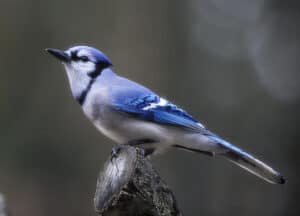
Many of Westford’s birds have migrated south by now, and we miss seeing them at our feeders and hearing their songs in our yards and woods. But, late fall and winter bring new opportunities. This is the time to really pay attention to and learn about our resident birds. There is much to learn about even our most common birds. I have been intrigued by blue jays lately. They are members of the Corvid family, along with crows and ravens, and have many of the same characteristics. Jays are highly social and intelligent, and have a large “vocabulary”. They have numerous songs and calls, just a few of which have been recorded and translated. They are great mimics as are other corvids. Jays can mimic all species of hawks in their areas, and many other birds. In captivity they learn to mimic human voices and even cell phone rings.
The parent birds have fledged their young, and the young have been taught to use our feeders. All day they practice a myriad different songs and calls, with greater or less proficiency. Their hawk calls are usually given near a feeder, to scare away any other birds who are taking up space on the feeder. I have often been fooled that a hawk is in the yard, when on further inspection the caller is a blue jay.
Blue jays are hard to ignore–they are large, loud and brightly colored birds, with a beautiful crest on the head. The crest is raised when the bird is feeling upset or aggressive, lowered when peaceful and non-threatening. Jay’s blue coloring and the elaborate patterning of their feathers, makes them stand out. The blue color is not a pigment, but is a function of the structure of the feathers that reflects blue light. This phenomenon is seen in many birds; much like the red throat of a male ruby-throated hummingbird. Male and female blue jays appear alike to our eyes, but it is likely that UV light, which birds see well, would reveal differences. There are also differences in behavior and some calls. For instance, the “rattle call” is given only by females near the nest, perhaps to scare away predators. And the “squeaky gate” call is only given by males near the nest.
Blue jays are long-lived, up to 17 years in the wild, and tend to mate for life. They are highly social and intelligent. Males are larger than females. The female does all the incubating of the eggs, so if you see a blue jay on a nest, its a female. Meanwhile, the male feeds himself, his mate, and does most of the feeding of the nestlings. He’s a hard worker and a good Dad. Jays are omnivores, preferring such foods as nuts, seeds, berries, and insects. They especially love acorns and one study showed an individual jay caching (burying) 3-5,000 acorns in one season.
A good way to learn more about blue jays is to visit YouTube and watch videos by Leslie the Bird Nerd. Leslie has studied the blue jays at her feeders for many years, and knows them personally. Jays love whole peanuts in the shell, and Leslie has discovered that blue jays are extremely adept at catching whole peanuts tossed up in the air, and has videos of this activity. This could be fun to try at home!
Many thanks to all flora and fauna reporters for the month of October. Please send reports by November 26, to appear in next month’s column. You can call me at 692-3907, write to me at 7A Old Colony Drive, or e-mail me at mariancharman@gmail.com.
———————–
October Reports:
Marian Harman, Old Colony Drive. October 1, chipmunks, red squirrel, two gray catbirds, lots of blue jays, crows, lots of chickadees, hairy woodpecker, downy woodpecker, pileated woodpecker, goldfinch, titmouse, lots of chickadees, white-breasted nuthatches, small sugar maple along the trail. October 3, walk to the beaver dam: The open area of the forest where most of the trees fell due to the storm in May, was loaded with migrating flycatchers and warblers, yellow-rumped and several other species. Flicker, downy woodpecker, red-bellied woodpecker, chickadees, white-breasted nuthatch, Carolina wren. October 7, sunny, in the 60’s. Walk on the trail, pair of mallards and a great blue heron on Keyes pond. Chickadees, nuthatches, titmice, blue jays, crows, downy woodpecker, red-bellied woodpecker, mystery flycatcher (not a phoebe), witch hazel blooming. October 10, 70’s and sunny. A beautiful golden October day–only in New England! Two chipping sparrows, female hairy woodpecker, goldfinches, chickadees, jays, downy woodpecker. A walk on the trails: The white-throated sparrows have arrived. They were excitedly eating in the shrubs lining the pond. Their voices, ” peabody, peabody, peabody”, are very weak now–breeding season is over. October 23, 60’s, foggy, then partly sunny. Walk to the beaver dam. Saw a beaver swimming in circles in front of the dam, not at all nervous about me on the shore. It looks as if they have piled a lot of new branches on the dam. Also saw or heard, four chickadees, blue jays squabbling, two white-breasted nuthatches, two white-breasted nuthatches, two titmice, goldfinch, pair of hairy woodpeckers, downy woodpeckers, pileated woodpecker heard, red-bellied woodpecker, two dark-colored warblers in the shrubs by Keyes Pond. Several blooming witch hazel plants are in and near the wetlands at the end of the Pond. I look forward to seeing this last of the blooming shrubs in the woods every October. Looking through the forest, myriads of bright scarlet blueberry bushes can be seen, also pink leaved maple-leaved viburnum. A lovely soft day. October 24, saw my first junco with some other sparrows in the bushes around the front lawn.
Leslie Thomas, Old Colony Drive. October 2, bear walking down Pilgrim Drive 7:30 a.m.
Rosemarie Koester, Providence Road. October 2, Ruby-throated Hummingbird seen twice today. October 7, bear sitting in our back yard snaking at birdfeeders at 1:15 p.m. We stomped on the deck and yelled. He/she just looked at us thinking we are crazy. Finally got up and left, a few minutes later, he was up on court road. At 9pm a few days later, saw a bear on our outdoor camera, walking across the driveway. Feeders are now way up high–fine for the finches, but cardinals are a bit reluctant. Many house finches, purple finches, goldfinches, chickadees, tufted titmouse, pair of cardinals and juveniles, blue jays, grackles, three hawks circling overhead, doves, red-bellied, downy and hairy woodpeckers. A very persistent female downy woodpecker pecking on the house. Bird baths frequently used by birds including turkeys, squirrels and chipmunks. Eight turkeys wander through the yard, resident bunny munching on hostas, wasp nest in ground and quite busy, numerous bees seen on garlic onion, coyote crossing the road and at Tadmuck brook, garter snake seen on a hike. Much bittersweet growing around Westford, destroying trees and bushes.
Rose O’Donnell, Sassafras Road. October 4, six bluebirds in my yard, flitting about the shrubs and nesting boxes.
Nancy Eberiel, Depot St. Week of October 8, four blackbirds migrating through, magnificent large coyote in yard, a bear took down the feeder for the second time [lots happening right in the middle of Town!-MH]
Purna Bhagavathula, Pond View Circle. October 20, I am seeing a lot of blue herons, a couple of blue jays and a lot of what looks like Carolina wrens.
Anita Aubin, at the Peace Trail. October 10, beaver swimming back and forth the pond at dusk, slapping his tail very loudly on the water. Two Canada geese landing on the pond at the same time, honking loudly.
Marian Harman is a member of the Westford Conservation Trust. The Trust’s mission is the preservation of Westford’s open spaces and trails. The Trust welcomes new members and volunteers. Check out our website at westfordconservationtrust.org or visit us on Facebook.
